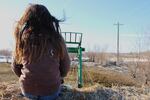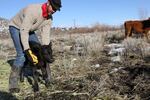
Madeleine Johnson rides atop hay bales as her brother Benjamin drives the tractor to feed the cows early one February morning.
Amanda Peacher / OPB
Eleven days after the occupation of the Malheur National Wildlife Refuge ended, the community of Harney County is taking a collective deep breath.
The fences and concrete barricades that surrounded the county courthouse in Burns are gone, but on the front doors, a new sign asks visitors to leave any guns in vehicles before they enter.
Bureau of Land Management employees are back to work in federal offices, but with new fencing around the buildings. Thirty miles away, the refuge itself remains blocked from the public while federal investigators go through the crime scene.
Related: 41 Days: An OPB Documentary On The Oregon Occupation
After more than five weeks of angst and tension in Burns, things are noticeably quieter in this small, high desert community. But it’s not quite a return to normal, at least not yet. Even as residents try to reset and to get back to routines, many see Harney County as changed.
At an elementary school basketball game, Tara McLain cupped her hands around her mouth, cheering for her 10-year-old son on the court.
“I just feel good,” McLain said.“Normal. Normal is good.”
There’s a big difference between that normal McLain feels today versus how she felt during the occupation.
“I don’t have constant fear,” she said.
A Bureau of Land Management employee, McLain’s life was turned upside down during the 41 day standoff. She had to work from home while federal offices were closed. Her husband is a sheriff’s deputy, and both worried they could be targets for anti-federal government militia.
McLain likes to jog, but she didn't feel comfortable running outside since mid-November, when leaders of the eventual occupation first showed up in Burns to support ranchers Dwight and Steve Hammond.
On a few occasions in January, her husband noticed strange footprints and vehicle tracks outside their house, in fresh snow. McLain told her kids they couldn't be home alone anymore. And that included her teenage daughter.
"That was hard," said McLain. "She was like, 'Why do I have to go to the store with you?'''
The occupation was on her entire family's mind, all the time. McLain made a rule that they couldn't talk about it at the dinner table.
For a while, she wondered if a majority of her friends and neighbors really did feel like she didn't matter as a federal employee.
"There were some people who were really vocal on Facebook. I kept telling myself that we had a lot of support out there, but they just weren't vocal about it," she said. "The coyotes are the loudest, you know?"
But McLain says despite her fears of outsiders with guns she gradually grew to feel good about her role as a federal employee. She started talking to her neighbors again, rather than just communicating on Facebook.

BLM worker Tara McLain says it feels good to do normal activities, like watch her son's basketball game, now that the occupation is over.
Amanda Peacher / OPB
“Everybody was feeling really isolated,” she said. “People wanted to communicate face-to-face.”
McLain said it was reaffirming when hundreds of locals showed up to rally in support of agency workers like her, and for law enforcement. As a federal worker, she feels more supported now than she did even before the occupation.
“As far as the emotional injury … it’s still very obvious.”
Some Harney County residents don’t want things to go back to the status quo.
On a small ranch just outside of Hines, about forty miles from the refuge, Rodney Johnson’s 10-year-old son Benjamin drove a tractor towing trailer full of hay toward a herd of cows early Friday.
A new calf had been born just the day before, and all five of Johnson’s kids piled onto the hay bales to go and take a look. This was the first calf of the season for their small family ranch.
“Is it a heifer?” said Benjamin, as his dad deftly caught the squirming black calf.
“Bull,” said Johnson. The kids sighed with disappointment. In the world of ranching, female cows are often prized over males.
Johnson pierced the calf’s ear with a numbered tag and then let it go bawling toward its mother.The refuge occupation didn’t have much of an effect on their family.

For rancher Rodney Johnson and his five kids, life after the occupation isn't much different from life during. Johnson tags the ear of a newborn calf.
Amanda Peacher / OPB
“Life hasn’t been too much different, other than the conflict in town with the community,” said Johnson.
He and his wife Debbie Johnson found themselves opposite friends in that conflict, in part because the Johnsons visited and spoke with the occupiers at the refuge.
“Their tactics were illegal and wrong,” Rodney Johnson said. “But I fully support their message.”
The Johnsons emphasize that they also support local federal employees. But they’re among some in Harney County who want to do something to curb what they see as government overreach, like certain federal policies on grazing or presidential designations of national monuments.
Debbie Johnson is helping organize local meetings to build on the momentum created by the occupiers.
“My goal at this point is taking this ball that we’ve got and keeping it going and making it bigger,” she said. Right now, the group is exploring different options to get involved with local governance. Some people want to confront large environmental groups, others see a need for change in school curricula and county government. But they agree that they want to see change in how government works.
In many ways, Burns still feels tense. Some friends still aren’t speaking. Debates carry on in social media and conflicts continue.
“It may be a little bit calmer, people are relieved that there’s fewer guns in town. But as far as the emotional injury that has occurred, it’s still very obvious,” said Johnson.
BLM worker Tara McLain agreed that it could take a while for the community of a few thousand to heal. At the end of the day, parents with kids on the same basketball team will still sit next to each other in the bleachers and be polite, even if they disagree.
“Burns is a great place, and I do think we’re going to come away from this even stronger,” said McLain. “I just hope that this isn’t what we’re known for.”